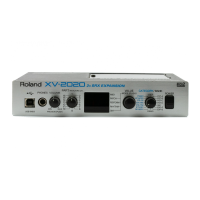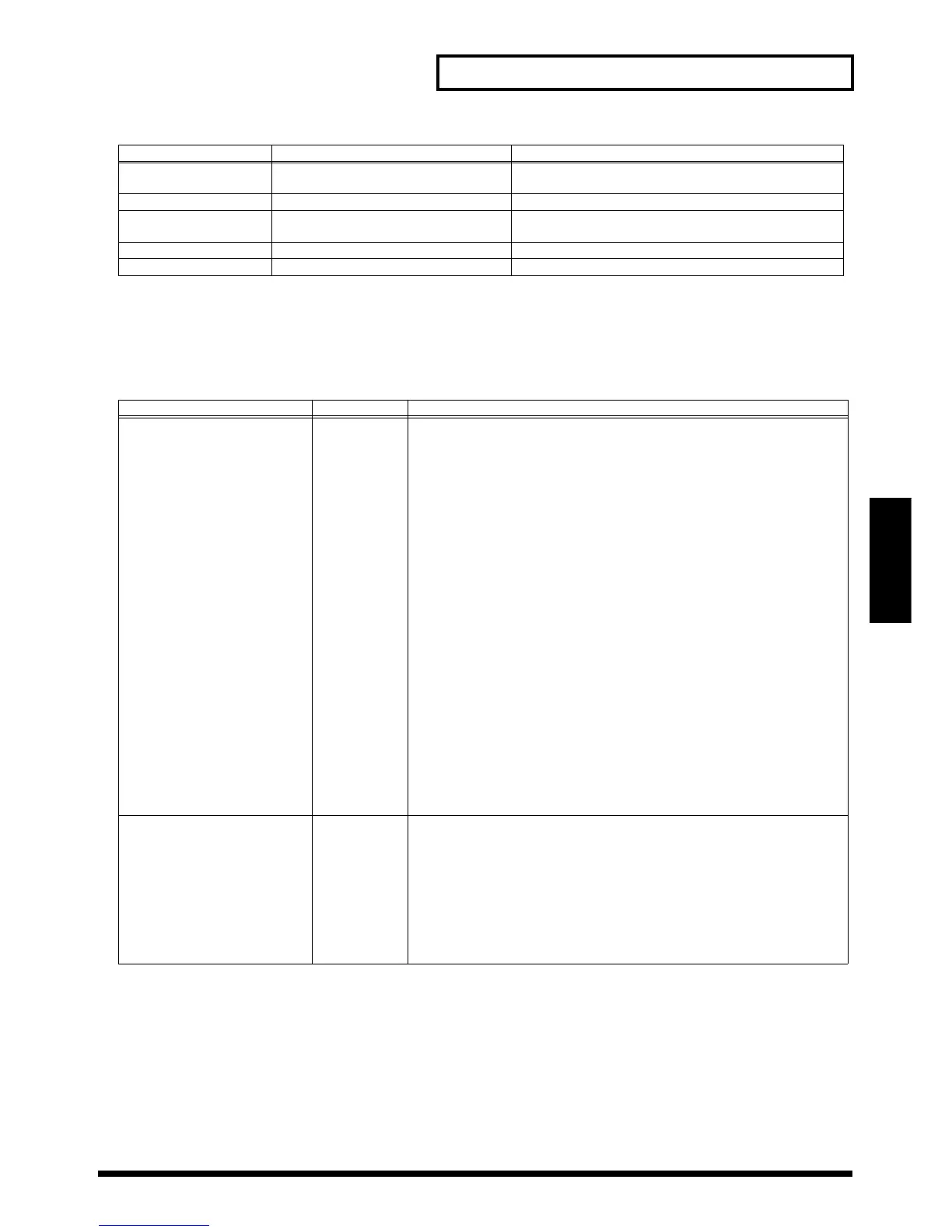57
Creating a Patch
Creating a Patch
* Noise may result from making the LFO PAN DEPTH too deep. To prevent noise, you can either lower the value
for the PAN DEPTH, or lower the LFO Rate.
PATCH TVF (Changing the Brightness with a Filter)
The settings for the TVF (Time Variant Filter) allow you to change a Tone’s timbral content by altering its
brightness or thickness.
LFO1(2) KEY SYNC
(LFO Key Sync)
OFF, ON Sets whether you want the LFO cycle to start in sync with the
timing of a key press (ON) or not (OFF).
LFO1(2) PITCH DEPTH -63–+63 Adjusts how much the LFO affects the Tone’s pitch.
LFO1(2) TVF DEPTH -63–+63 Adjusts how much the LFO affects the Tone’s TVF cutoff fre-
quency.
LFO1(2) TVA DEPTH -63–+63 Adjusts how much the LFO affects the Tone’s TVA Level.
LFO1(2) PAN DEPTH -63–+63 Adjusts how much the LFO affects the Tone’s TVA Pan.
Parameter Value Description
FILTER TYPE OFF, LPF, BPF,
HPF, PKG,
LPF2, LPF3
Selects a filter type. A filter typically reduces, or attenuates, a specific frequency
range within a Tone in order to accentuate its other frequencies.
OFF: No filter is used.
LPF: A Low Pass Filter reduces the volume of frequencies above the cutoff fre-
quency in order to un-brighten the sound. This is the most common filter used
in synthesizers.
BPF: A Band Pass Filter reduces the volume of frequencies below and above the
cutoff frequency range. This is most effective when creating sounds with a
strong character since it can accentuate a desired range of frequencies anywhere
in the sound.
HPF: A High Pass Filter reduces the volume of the frequencies below the cutoff
frequency. This is suitable for creating percussive sounds by rolling of their low-
er frequencies, thus emphasizing their higher ones.
PKG: A Peaking Filter emphasizes frequencies around the cutoff frequency by
raising their level. You can use this to create wah-wah effects by employing an
LFO to change the cutoff frequency cyclically.
LPF2: Low Pass Filter 2. This reduces the volume of all frequencies above the
cutoff frequency. This differs from LPF in that you can control the amount of the
reduction using the TVF ENVELOPE settings while still maintaining a fixed cut-
off frequency. This can be very effective with acoustic-instrument-based Tones,
since nothing is done to weaken the power and energy of the sound.
* This disables the Resonance setting.
LPF3: Low Pass Filter 3 reduces the volume of frequencies above the cutoff fre-
quency. While similar to LPF2, it reduces the frequencies more gently than LPF2.
This can also be effective with acoustic-instrument-based Tones.
* This disables the Resonance setting.
CUTOFF
(Cutoff Frequency)
0–127 Adjusts the frequency at which the filter begins to have an effect on the waveform’s
frequency components. With LPF/LPF2/LPF3 selected for the Filter Type param-
eter, lower cutoff frequency settings reduce a Tone’s upper harmonics for a more
rounded, warmer sound. Higher settings make it sound brighter. When Filter Type
is BPF, the cutoff frequency setting determines the range of frequencies within the
Tone that will be heard. This can be useful when creating sounds that need to stand
out. When Filter Type is HPF, higher settings of the cutoff frequency decrease the
level of the Tone’s low frequencies, preserving its brighter qualities. When Filter
Type is PKG, the cutoff frequency setting determines the range of frequencies to be
emphasized.
Parameter Value Description

